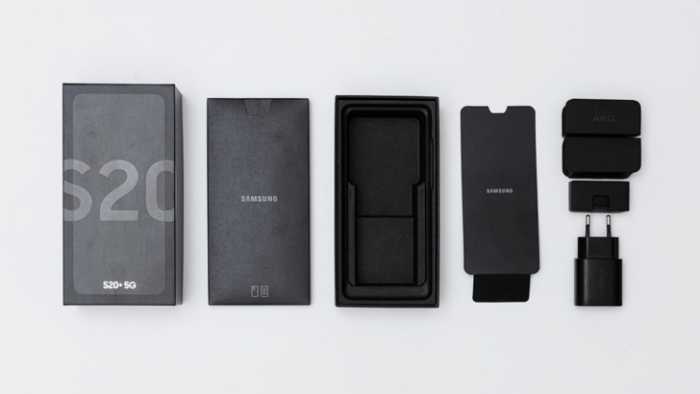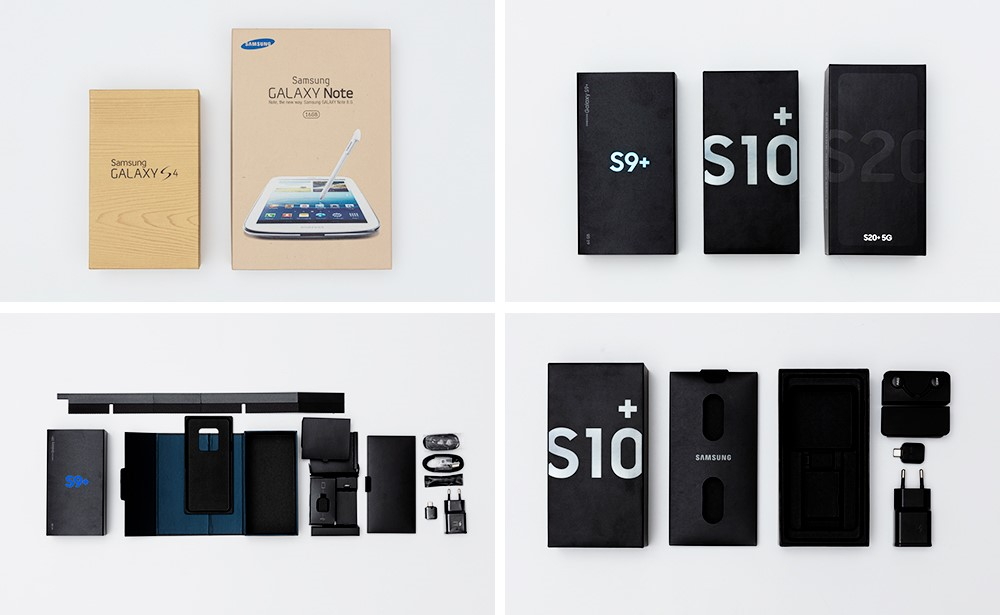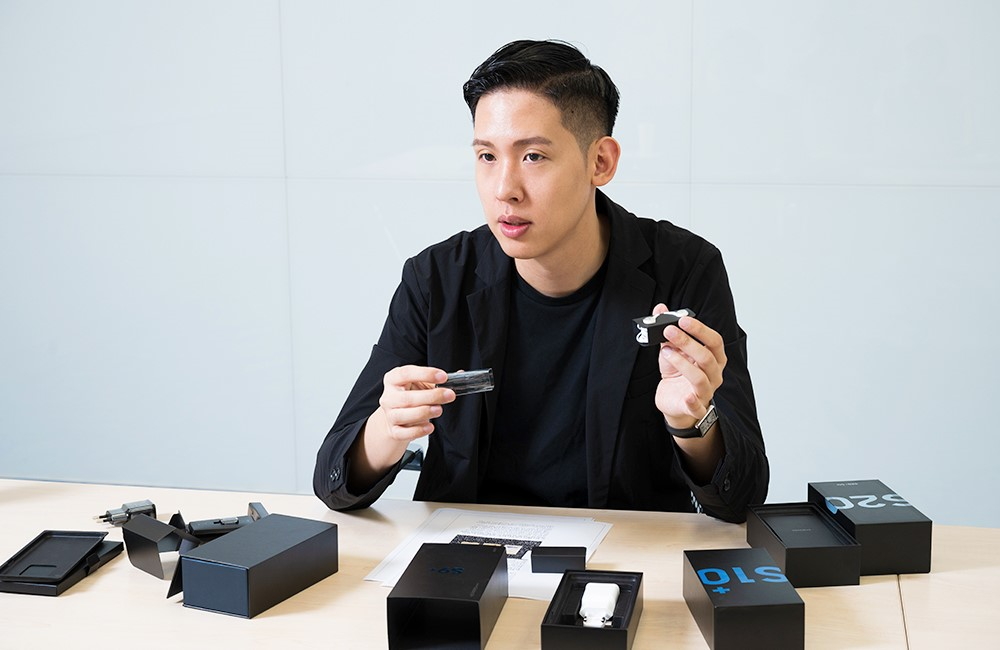
According to a 2018 report by the United Nations Environment Programme (UNEP) entitled “Single-Use Plastics: A Roadmap for Sustainability,” unless the world improves its consumption patterns and waste management practices, by 2050, there will be roughly 12 million metric tons of plastic litter polluting landfills and the environment.
It’s hard to overstate the urgency of this issue. Thankfully, people around the world, especially the younger generation, are realizing the importance of environmentally conscious consumption, and are adopting products and solutions that put the planet first. Samsung Electronics is deeply committed to this cause, and has taken steps to make its products as green as can be.
Read on to learn how, by reducing the use of plastics and vinyl in packaging, and by crafting phone cases from recycled materials, Samsung’s designers are promoting a much more sustainable smartphone experience.

Design Team members Mogwon Son (left) and Yoonyoung Kim, from Samsung Electronics’ Mobile Communications Business
A Decade of Going Green

The evolution of Galaxy devices’ packaging can be summed up with what could be called the three R’s: reducing paper use by streamlining packaging’s dimensions, replacing plastic with paper, and removing unnecessary components by simplifying packaging’s structure. Adhering to these green values enabled Samsung to make the Galaxy S10+’s packaging 30g lighter than that of its predecessor.
The Galaxy S series’ environmentally conscious packaging is the culmination of 10 years of hard work. Two thousand twelve’s Galaxy S3 was the first device in the series to feature recycled material in its packaging. The next year, Samsung officially introduced its first environmentally conscious mobile packaging, created using discarded paper, with the Galaxy S4. The Galaxy S5 and more recent entries in the series have added even more environmentally conscious elements to the mix, including biodegradable vinyl1 and petroleum-free soy ink.
Design Team member Mogwon Son discussed how Samsung equipped last year’s Galaxy S10 with eco-friendly packaging consisting of FSC-certified paper boxes, as well as plastic- and vinyl-free interior components. “We abandoned the holder tray and the box-covering sleeve, but kept the bottom box, which includes an all-in-one pulp mold,” said Son.2 “This pulp mold, which utilizes pulp slurry made from bamboo fibers and sugarcane bagasse, is better for the environment, and helps minimize waste.”

The Galaxy S9, S10 and S20’s earphones (left) and travel adapters (right), displayed in order of release. As you can see, plastic films are no longer used to protect these products in packaging.
To further minimize waste, the plastic films that were used to wrap accessories like chargers and earphones have been phased out. Now, Galaxy devices’ earphones and cables come neatly packed in a paper box. So too do their chargers, which also now feature matte finishes rather than the glossy sheens that previously required protective plastic film.
Sustainability Meets Style
Durability, aesthetics, and suitability for mass production – these are the most important elements of packaging design. Because the Galaxy S series is Samsung’s flagship smartphone line, consumers expect these products and their packaging to look and feel as premium as possible. As Son explained, the process of creating a premium packaging design with recycled materials presented some unique challenges.

“First of all, it can be difficult to apply specific colors to a pulp mold,” said Son. “The surface of this material is curved and rough, which means that coloring it will require some retouches. Once it’s formed, the pulp mold may appear reddish or blue, and it can look like it’s stained depending on the recycled materials that were used to create it. In the end, the process of achieving a clean and even black hue required a lot of trial and error.”
According to Son, the process of making Samsung’s existing packaging processes greener presented a number of challenges. The team overcame those hurdles, he explained, by devoting the time, money and effort necessary to make it happen.
“Sure, it was difficult, but the reason it was difficult is that these designs need to keep up with the needs of the times,” said Son. “In the end, we wanted to offer a better experience with paper packaging than users would have with plastic or vinyl. This is why we chose to accentuate the soft texture of the pulp material itself, and devoted a great deal of effort to refining the packaging’s exterior.”

The Galaxy S20+ 5G’s environmentally conscious packaging features minimal use of plastics and vinyl
Not only has the team’s hard work made Samsung’s packaging more sustainable, it’s also made it that much more convenient. Whereas in the past, users would need to separate packaging components in order to properly dispose of them, because the Galaxy S20’s packaging is crafted entirely from paper, it’s 100-percent recyclable.
“I’ve made it my mission to create high-quality packaging that can be recycled easily to help protect the environment,” said Son. “To achieve this, I started to consider how the packaging would ultimately be discarded and recycled from the initial planning stage. Going forward, I’ll continue to explore sustainable packaging designs based on the philosophy, ‘the fewer, the better.’”
Putting Plastic Waste to Work with Environmentally Conscious Cases

At first glance, the Galaxy S20+’s Kvadrat case appears stylish and modern. Thin, but durable enough to protect the device from the wear and tear of everyday life.
Upon closer inspection, it becomes clear that there’s more to this particular case than meets the eye. That’s because the Galaxy S20+’s Kvadrat case has been made through upcycling – a process in which end-of-life products are transformed into new, environmentally conscious products and materials. Using this process, Samsung and premium Danish textile brand Kvadrat can produce two striking Galaxy S20+ cases from a single 500ml plastic bottle.

Samsung’s collaboration with Kvadrat, an environmentally conscious company that has obtained the European Union’s famously rigorous Ecolabel certification, dates back to 2018. The project’s lead designer, Yoonyoung Kim, explained how she arranged to meet with Kvadrat prior to attending an overseas furniture exhibition. When she visited Kvadrat’s showroom in Milan, she fell in love with the textiles on display.
When the companies eventually kicked off their collaboration, the process of meeting Samsung’s premium design standards without sacrificing Kvadrat’s charming aesthetic required a fair bit of coordination.
Much like aesthetics, durability is key when it comes to smartphone cases. This meant that the Galaxy S20+’s Kvadrat case would need to be not just thin, but ladder-proof as well. To achieve this, Kim worked with developers to find a way to prevent the case’s knitted fabric from unraveling at its edges. After testing out a variety of methods, her team managed to optimize the finishing process, and enhance Samsung’s equipment to properly manufacture the products. The result of these extensive efforts is one beautiful ‘green’ case – the first product produced in collaboration with the company to feature the Kvadrat logo.

The Galaxy S20+’s Kvadrat case is the first product produced in collaboration with the company to feature the Kvadrat logo
Recently, global fashion houses have been increasing their investment in environmentally conscious materials. The trend, Kim explained, is about shunning leather and polyurethane-coated materials in favor of more environmentally conscious alternatives.
“When compared to typical synthetic polyester yarns, the recycled yarns used in this case are less uniform in diameter, and they’re so delicate that it’s difficult to weave them into elaborate patterns, which requires a careful and exacting finishing process,” said Kim. “Going green is not a fad – it’s a global shift in perception, and the mission of all manufacturers. Therefore, we cannot stop here. Through our ongoing partnership with Kvadrat, we will continue to create innovative accessory designs that combine expressive patterns and colors with optimum usability.”
Promoting Environmentally Conscious Lifestyles
Kim is correct in her assertion that going green is not a fad, but a mission that we should all get behind, as we live on a planet with limited resources. The aforementioned UNEP report also emphasizes our communal role in solving environmental issues, noting that governments, businesses and individuals should each do their part.
When it comes to going green, both designers stress the importance of taking a step-by-step approach until greenness has become fully engrained in our lives. They acknowledge that starting this transition can be difficult, and sticking to it can be even more so. “At the moment, the idea of going green may be viewed as a trend, and while there is a consensus that everyone should follow it, there is a possibility that this trend could fade later on,” both said in unison. “We sincerely hope that this isn’t the case, and that environmental consciousness becomes a deeply rooted aspect of our lives.”
The designers will continue to work tirelessly to persuade mobile device users to adopt a more environmentally conscious lifestyle. “I think that designing simple packaging like this is important,” said Son, “and I will continue to do my part to find materials that satisfy users from the moment they open the packaging until the moment they dispose of it.”
“By utilizing materials that not only allow us to create all-new designs with natural and beautiful colors – something which was previously thought to be possible only with delicate natural fibers – but are also environmentally conscious even at the injection molding stage,” added Kim, “I will continue to do my best to ensure that the products we develop offer users the satisfaction of contributing to making the world a better place for all.”
1 Available only in select markets, including the UAE and Saudi Arabia.
2 Pulp mold material was first introduced with the Galaxy S9’s environmentally conscious packaging in 2018.
